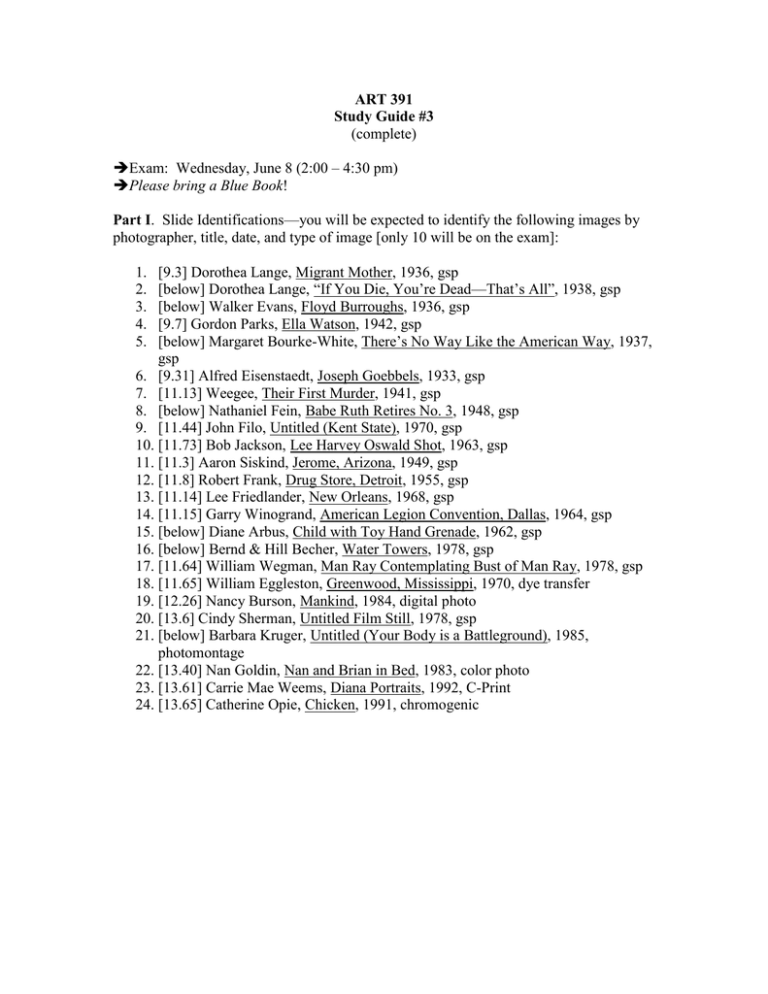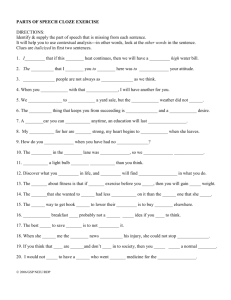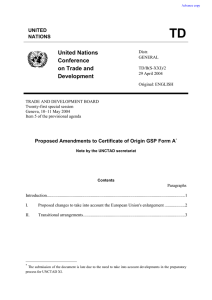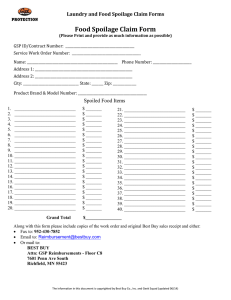Images
advertisement

ART 391 Study Guide #3 (complete) Exam: Wednesday, June 8 (2:00 – 4:30 pm) Please bring a Blue Book! Part I. Slide Identifications—you will be expected to identify the following images by photographer, title, date, and type of image [only 10 will be on the exam]: 1. 2. 3. 4. 5. [9.3] Dorothea Lange, Migrant Mother, 1936, gsp [below] Dorothea Lange, “If You Die, You’re Dead—That’s All”, 1938, gsp [below] Walker Evans, Floyd Burroughs, 1936, gsp [9.7] Gordon Parks, Ella Watson, 1942, gsp [below] Margaret Bourke-White, There’s No Way Like the American Way, 1937, gsp 6. [9.31] Alfred Eisenstaedt, Joseph Goebbels, 1933, gsp 7. [11.13] Weegee, Their First Murder, 1941, gsp 8. [below] Nathaniel Fein, Babe Ruth Retires No. 3, 1948, gsp 9. [11.44] John Filo, Untitled (Kent State), 1970, gsp 10. [11.73] Bob Jackson, Lee Harvey Oswald Shot, 1963, gsp 11. [11.3] Aaron Siskind, Jerome, Arizona, 1949, gsp 12. [11.8] Robert Frank, Drug Store, Detroit, 1955, gsp 13. [11.14] Lee Friedlander, New Orleans, 1968, gsp 14. [11.15] Garry Winogrand, American Legion Convention, Dallas, 1964, gsp 15. [below] Diane Arbus, Child with Toy Hand Grenade, 1962, gsp 16. [below] Bernd & Hill Becher, Water Towers, 1978, gsp 17. [11.64] William Wegman, Man Ray Contemplating Bust of Man Ray, 1978, gsp 18. [11.65] William Eggleston, Greenwood, Mississippi, 1970, dye transfer 19. [12.26] Nancy Burson, Mankind, 1984, digital photo 20. [13.6] Cindy Sherman, Untitled Film Still, 1978, gsp 21. [below] Barbara Kruger, Untitled (Your Body is a Battleground), 1985, photomontage 22. [13.40] Nan Goldin, Nan and Brian in Bed, 1983, color photo 23. [13.61] Carrie Mae Weems, Diana Portraits, 1992, C-Print 24. [13.65] Catherine Opie, Chicken, 1991, chromogenic Lange Evans Bourke-White Fein Bechers Arbus Kruger Part II. Essay Questions—3 of the following 5 questions will be on your Final Exam. You will be asked to choose 2 of them to answer: 1. Farm Security Administration—what was the purpose of this program? Explain the intention of these FSA photographers, using the following images as examples. Then discuss the “real” story that they ultimately capture: a. Walker Evans, Floyd Burroughs, a cotton sharecropper, AL, 1936, gsp b. Gordon Parks, Ella Watson (American Gothic), 1942, gsp c. Dorothea Lange, “If You Die, You’re Dead—That’s All” (Nettie Fetherston), 1938, gsp 2. Photojournalism—what is photojournalism? Discuss the following images in terms of timeliness, objectivity, and narrative: a. Nathaniel Fein, Babe Ruth Retires No. 3, 1948, gsp b. John Filo, Untitled (Kent State), 1970, gsp c. Bob Jackson, Lee Harvey Oswald Shot, 1963, gsp 3. Straight Photography—what is “straight” photography? Explain using the following images. Then discuss how Winogrand’s brand of “street” photography differs from the previous generation (like Kertesz or Cartier-Bresson). a. Robert Frank, Drug Store, Detroit, 1955, gsp b. Lee Friedlander, New Orleans, 1968, gsp c. Garry Winogrand, American Legion Convention, Dallas, 1964, gsp 4. Postmodernism—although Postmodernism can be difficult to define, in terms of photography, it seems to go hand in hand with interrogating notions of reality and of originality. Expand on this notion, analyzing various PoMo strategies, such as working serially, appropriation, exploring digital photography, using the following images: a. Bernd & Hill Becher, Water Towers, 1978, gelatin silver b. Carrie Mae Weems, Diana Portraits, 1992, C-Print c. Nancy Burson, Mankind, 1984, digital photo 5. Identity Politics—explain this idea of interrogating the body as a site of “meaning.” How do the following photographers challenge assumptions about gender and sexuality? a. Cindy Sherman, Untitled Film Still, 1978, gelatin silver b. Barbara Kruger, Untitled (Your Body is a Battleground), 1985, photomontage c. Catherine Opie, Chicken, 1991, chromogenic



